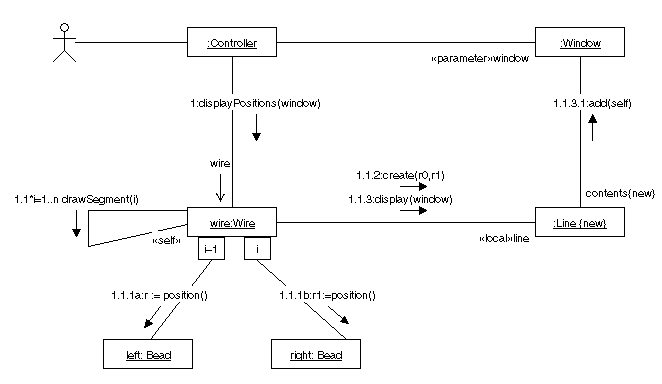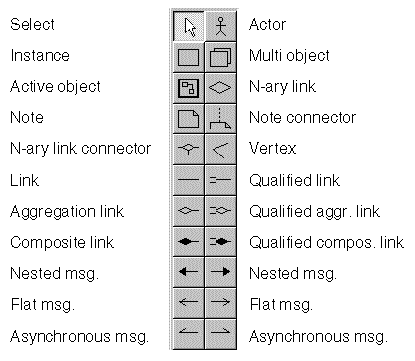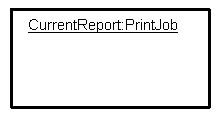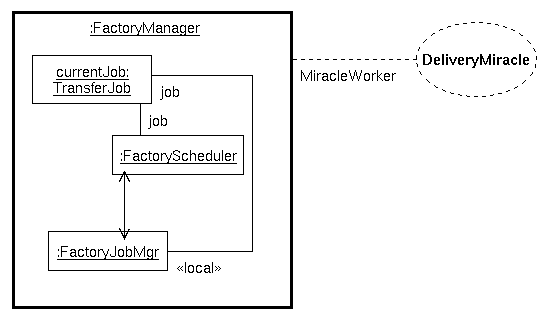|
Purpose
A collaboration diagram shows the objects and relationships involved in an interaction, and the sequence of messages exchanged among the objects during the interaction.
Compared with a sequence diagram
A sequence diagram shows the objects and messages involved in an interaction. It shows the timing of the messages, but not the relationships among the objects.
As a decomposition diagram
The collaboration diagram can be a decomposition of a class, class diagram, or part of a class diagram; it can be the decomposition of a use case, use case diagram, or part of a use case diagram.
Example COD
A sample collaboration diagram.

Control panel
The control panel of the collaboration diagram.

Actors, Instances, and Objects
Actor
An actor in a collaboration diagram represents the person, software, hardware, or other agent external to the system that is interacting with the system.

Label
name
Instance
An instance in a collaboration diagram represents an instantiation of a class in a class diagram or a use case in a use case diagram

Label
[instance-name][:instance-type]
instance-name is the name of the instance
instance-type is a class or a use case
Note: While both elements of the label are optional, you must provide one of them to avoid check errors.
Multi object
A multi object represents a set of instances at the many end of an association. If necessary, you can use the instance symbol to show one instance of the set and a composite link symbol to show that the instance is part of the multi object.

Label
[name][:type]
name is the name of the multi object
type is a class or a use case
Note: While both elements of the label are optional, you must provide one of them to avoid check errors.
Active object
An active object is an instance that owns a thread of control and can initiate control activity. For example, processes and tasks are active objects. Active objects can contain other symbols and links among them.

Label
[name][:type]
name is the name of the active object
type is a class or a use case
Note: While both elements of the label are optional, you must provide one of them to avoid check errors.
Links
Links in collaboration and class diagrams
The links (associations, aggregations, and so on) in a collaboration diagram show the paths available for messages; they do not provide detailed information about the links. For example, the links in a collaboration diagram do not show the multiplicity of the links. The class diagram defines the links, providing detailed information about them.
Descriptions of the links
For more information about each type of link provided in the collaboration diagram, see the class diagram description.
Labels for links
Each link in a collaboration diagram has two role labels and a name label:
The role names in a collaboration diagram should be the same as the role names in a class diagram. Use the stereotype property of the role names to specify the link start and link end stereotypes.
Messages
Messages
A message flow carries a message from one object to another along any type of connector (link, aggregation link, and so on). Each message flow in a collaboration diagram is characterized by direction and type.
Creating and moving messages
You must create a connector before you can create a message. You can place message symbols on or near a connector, moving them if necessary to prevent them from overlapping the connector. When you move a connector, its message symbols move with it.
Message direction
There are two message directions:
Backward Messages
Forward Messages
The direction in which the link was drawn determines the direction of the message.
Message type
You can create these types of messages:
Nested message
Flat message
Asynchronous message
Message syntax
The default syntax for a message name is:
<predecessor> <guard-condition>
A comma-separated list of sequence numbers followed by a slash. The clause is omitted when the list is empty.
<sequence-expression>
A dot-separated list of numbers or names, optionally followed by a condition or an iteration (both enclosed in square brackets, the iteration preceded by an asterisk) and separated from the rest of the label by a colon.
<return-value> [ = | := ]
A data element with scope file. If the message does not return a value, the return value and the assignment operator are omitted.
<message-name>
A process element with scope system.
<argument-list>
A comma-separated list of data elements with scope file. This list is enclosed in brackets and can be empty.
Nested message
The nested message represents a procedure call or other nested flow of control. The nested sequence is completed before the outer level sequence resumes. The nested message symbol is represented by a filled solid arrowhead.

Flat message
The flat message shows the progression to the next step in a sequence. The flat message symbol is represented by a stick arrowhead.

Asynchronous message
The asynchronous message symbol shows an asynchronous message between two objects. The asynchronous message symbol is represented by a half stick arrowhead.

Patterns
Availability
The Collaboration Diagram provides the design pattern and the design pattern connector. With the connector, you can connect a design pattern to instances, multi objects, active objects, and actors. In a Collaboration Diagram, these symbols play a role for the design pattern.

See Patterns (in the Class Diagram's description) for more information about patterns in the UML suite.
| 